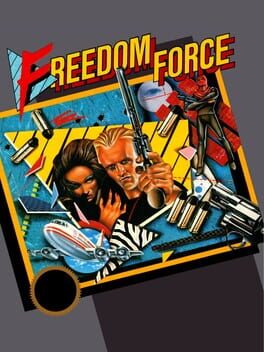Nintendo's early explorations of the NES Zapper took two different forms. While Duck Hunt (1984) is the best-known example of a fixed shooter, Gumshoe (1986) offered a dynamic side-scrolling formula in a rather absurd platformer concept. All the major Japanese developers tried to use the Zapper in one of their games, with little success. Gotcha! The Sport! (1987) by Sanritsu Denki and LJN had very poor ergonomics, while the NES port of Taito's Operation Wolf (1989) gutted the arcade title. Around the same time, Sunsoft released Freedom Force, which was designed specifically for the NES. With its automatic horizontal scrolling, the game was reminiscent of Hogan's Alley (1984), but differed in that it spawned enemies continuously, not just during still scenes. The player takes on the role of Rad Rex, an anti-terrorist operative tasked with rescuing hostages from a plane hijacked by a group of anarchists.
The title's difficulty is particularly harsh, requiring almost impossible levels of reaction, especially given the poor accuracy of the Zapper. Enemies start firing a few tenths of a second after coming out of hiding, draining the player's health bar in a matter of moments. The main problem lies in the way the game dispenses ammunition and recharges the player's health bar. Instead of placing the items on the actual shooting area, like all other games that use the Zapper, Freedom Force makes them appear in the lower right-hand corner of the screen, away from the action. Because their timer is so short, the player is forced to keep a constant eye on this part of the screen and be prepared to make a long motion to shoot for the refills. This makes it difficult to focus on the enemies and adjust one's aim. Most of the time, the player is not quick enough to get the bonuses or loses the recovered health immediately after a deadly salvo from enemies that have appeared in the meantime. The player can also swap weapons by shooting the corresponding bonus, but the effects are insignificant. The only exception is the grenade launcher, which decimates everyone on the screen – enemies and innocent civilians alike – and proves to be an exceptional downgrade.
Despite the brevity of the experience – just five stages, each lasting just a few dozen seconds – Freedom Force is remarkably unfair and unpleasant, never helped by the disconcerting and completely out-of-place Hangman word-game interludes. Perhaps most notable is the presence of on-screen blood, though it never approaches the gore of Narc (1988) – whose censorship focused more on drug references – or Hokuto no Ken (1986). More generally, Freedom Force is riddled with design ideas that exacerbate the NES Zapper's already wayward handling. The result is a forgettable experience bathed in an obnoxious depiction of ultra-virile masculinity.
The title's difficulty is particularly harsh, requiring almost impossible levels of reaction, especially given the poor accuracy of the Zapper. Enemies start firing a few tenths of a second after coming out of hiding, draining the player's health bar in a matter of moments. The main problem lies in the way the game dispenses ammunition and recharges the player's health bar. Instead of placing the items on the actual shooting area, like all other games that use the Zapper, Freedom Force makes them appear in the lower right-hand corner of the screen, away from the action. Because their timer is so short, the player is forced to keep a constant eye on this part of the screen and be prepared to make a long motion to shoot for the refills. This makes it difficult to focus on the enemies and adjust one's aim. Most of the time, the player is not quick enough to get the bonuses or loses the recovered health immediately after a deadly salvo from enemies that have appeared in the meantime. The player can also swap weapons by shooting the corresponding bonus, but the effects are insignificant. The only exception is the grenade launcher, which decimates everyone on the screen – enemies and innocent civilians alike – and proves to be an exceptional downgrade.
Despite the brevity of the experience – just five stages, each lasting just a few dozen seconds – Freedom Force is remarkably unfair and unpleasant, never helped by the disconcerting and completely out-of-place Hangman word-game interludes. Perhaps most notable is the presence of on-screen blood, though it never approaches the gore of Narc (1988) – whose censorship focused more on drug references – or Hokuto no Ken (1986). More generally, Freedom Force is riddled with design ideas that exacerbate the NES Zapper's already wayward handling. The result is a forgettable experience bathed in an obnoxious depiction of ultra-virile masculinity.
2 Comments
@cowboyjosh: Yeah, the Zapper on Operation Wolf is (surprisingly?) worse in every aspect than the usual controller. But that's true of almost every NES game where the Zappen is only optional, ahah.

cowboyjosh
10 months ago